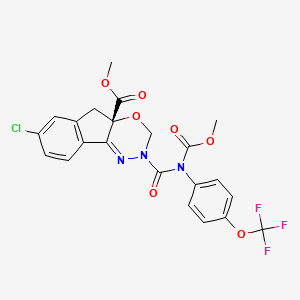

1. Dpx-mp062
1. 173584-44-6
2. (s)-indoxacarb
3. Steward
4. Insecticide
5. Provaunt
6. Advion
7. Avaunt
8. Indoxacarb [iso]
9. 52h0d26mwr
10. Indeno(1,2-e)(1,3,4)oxadiazine-4a(3h)-carboxylic Acid, 7-chloro-2,5-dihydro-2-(((methoxycarbonyl)(4-(trifluoromethoxy)phenyl)amino)carbonyl)-, Methyl Ester, (4as)-
11. Methyl (4as)-7-chloro-2-[methoxycarbonyl-[4-(trifluoromethoxy)phenyl]carbamoyl]-3,5-dihydroindeno[1,2-e][1,3,4]oxadiazine-4a-carboxylate
12. Chebi:38630
13. Indoxacarb (jan)
14. 174060-41-4
15. Methyl (4as)-7-chloro-2-{(methoxycarbonyl)[4-(trifluoromethoxy)phenyl]carbamoyl}-2,5-dihydroindeno[1,2-e][1,3,4]oxadiazine-4a(3h)-carboxylate
16. Avatar
17. Avent
18. Indoxacarb [jan]
19. (+/-)-indoxacarb;dpx-jw 062; Dpx-mp 062; Tornado; Tornado 10fl
20. Dpx-kn 128
21. Hsdb 7280
22. Dpx-mp 062-381
23. Unii-52h0d26mwr
24. Dpx-mp062
25. Indoxacarb 10 Microg/ml In Cyclohexane
26. (4as)-indoxacarb
27. Activyl
28. Indoxacarb [mi]
29. Indoxacarb [hsdb]
30. (+)-indoxacarb
31. Dsstox_cid_12690
32. Dsstox_rid_79034
33. Dsstox_gsid_32690
34. Indoxacarb, (+)-
35. Schembl22073
36. Dpx-kn128
37. Methyl (s)-7chloro-2,5-dihydro-2-(((methoxycarbonyl)(4-(trifluoromethoxy)phenyl)amino)carbonylindeno(1,2-e)(1,3,4)oxadiazine-4a(3h)-carboxylate
38. Chembl197676
39. Dtxsid1032690
40. Amy20519
41. Tox21_300723
42. Zinc28527855
43. Akos037643748
44. Ncgc00164264-02
45. Ncgc00164264-03
46. Ncgc00254629-01
47. As-35129
48. Indoxacarb (ema Epar: Veterinary)
49. Activyl Tick Plus Component Indoxacarb
50. Cas-173584-44-6
51. Indoxacarb, Pestanal(r), Analytical Standard
52. C18569
53. D06316
54. Indoxacarb Component Of Activyl Tick Plus
55. Q421469
56. (s)-methyl 7-chloro-2-(methoxycarbonyl(4-(trifluoromethoxy)phenyl)carbamoyl)-2,3,4a,5-tetrahydroindeno[1,2-e][1,3,4]oxadiazine-4a-carboxylate
57. Indeno[1,2-e][1,3,4]oxadiazine-4a(3h)-carboxylicacid,7-chloro-2,5-dihydro-2-[[(methoxycarbonyl)[4-(trifluoromethoxy)phenyl]amino]carbonyl]-,methyl Ester
58. Methyl (4as)-7-chloro-2,5-dihydro-2-(((methoxycarbonyl)(4-(trifluoromethoxy)phenyl)amino)carbonyl)indeno(1,2-e)(1,3,4)oxadiazine-4a(3h)-carboxylate
59. Pesticide3_indoxacarb_c22h17clf3n3o7_methyl (4as)-7-chloro-2-{(methoxycarbonyl)[4-(trifluoromethoxy)phenyl]carbamoyl}-2,5-dihydroindeno[1,2-e][1,3,4]oxadiazine-4a(3h)-carboxylate
| Molecular Weight | 527.8 g/mol |
|---|---|
| Molecular Formula | C22H17ClF3N3O7 |
| XLogP3 | 4.8 |
| Hydrogen Bond Donor Count | 0 |
| Hydrogen Bond Acceptor Count | 11 |
| Rotatable Bond Count | 5 |
| Exact Mass | 527.0707121 g/mol |
| Monoisotopic Mass | 527.0707121 g/mol |
| Topological Polar Surface Area | 107 Ų |
| Heavy Atom Count | 36 |
| Formal Charge | 0 |
| Complexity | 912 |
| Isotope Atom Count | 0 |
| Defined Atom Stereocenter Count | 1 |
| Undefined Atom Stereocenter Count | 0 |
| Defined Bond Stereocenter Count | 0 |
| Undefined Bond Stereocenter Count | 0 |
| Covalently Bonded Unit Count | 1 |
Treatment and prevention of flea infestation.
For dogs and cats: Treatment and prevention of flea infestation.
The veterinary medicinal product can be used as part of a treatment strategy for flea-allergy dermatitis. Developing stages of fleas in the pet's immediate surroundings are killed following contact with Activyl-treated pets.
QP53AX27
Metabolism in rats after oral dosing was studied using both DPX-JW062 and DPX-MP062. Most of the dose was excreted within 96 hr. Extensive metabolism to numerous minor metabolites occurs. In urine, metabolites were cleaved products (indane or trifluoromethoxyphenyl ring products), whilst in feces, major metabolites retained both these moieties. Major metabolic reactions included hydroxylation of the indane ring, hydrolysis of the carboxymethyl group from the amino nitrogen, and opening of the oxadiazine ring, which gave rise to cleaved products.
Tomlin CDS, ed. Indoxacarb (173584-44-6). In: The e-Pesticide Manual, 13th Edition Version 3.0 (2003-04). Surrey UK, British Crop Protection Council.
... Indoxacarb inhibits sodium channels and certain subtypes of nicotinic receptors.
PMID:12370061 Narahashi T; Mini Rev Med Chem 2 (4): 419-32 (2002)
The effects of the oxadiazine insecticide indoxacarb and its N-decarbomethoxylated metabolite (DCJW) on tetrodotoxin-resistant (TTX-R) voltage-gated sodium channels in rat dorsal ganglion neurons were studied using the whole-cell patch clamp technique. Indoxacarb and DCJW suppressed the peak amplitude of action potentials, and DCJW exhibited a faster time course and higher potency than indoxacarb in the blocking effects. In voltage-clamp experiments, indoxacarb and DCJW suppressed TTX-R sodium currents in a time-dependent manner without a steady-state level of suppression. IC50 values for indoxacarb and DCJW on TTX-R sodium currents were estimated to be 10.7 and 0.8 microM after 25 min of bath application, respectively. DCJW was about 10 times more potent than indoxacarb in blocking TTX-R sodium currents. Although the suppressive effects of indoxacarb were partially reversible after washout with drug-free external solution, no recovery of sodium current was observed in DCJW treated neurons after prolonged washout. In current-voltage relationships, both indoxacarb and DCJW blocked the sodium currents to the same degree in the entire range of membrane potentials. The sodium conductance-voltage curve was not shifted along the voltage axis by indoxacarb and DCJW at 10 microM. In contrast, the steady-state inactivation curves were shifted in the hyperpolarizing direction by indoxacarb as well as by DCJW. Based on these results, it was concluded that indoxacarb and DCJW potently blocked the TTX-R sodium channel in rat DRG neurons with hyperpolarizing shifts of the steady-state inactivation curves, suggesting preferential association of the insecticides to the inactivated state of sodium channels. The small structural variation between indoxacarb and DCJW resulted in clear differences in potency for blocking sodium channels and reversibility after washout.
PMID:12974351 Tsurubuchi Y, Kono Y; Pest Manag Sci 59 (9): 999-1006 (2003)